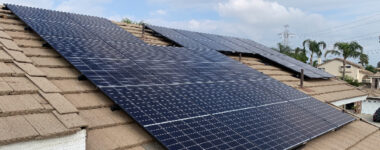San Diego Contractor | Solar Panels, Battery Storage, Roofing, HVAC
If you’re thinking about adding solar power to your San Diego home, you have a lot of choices when it comes to hiring local solar panel installation companies. So, what makes Semper Solaris different from the rest? First and foremost, we’re committed to offering our customers unparalleled service and the highest quality solar panels on the market. However, what really gets to the heart of our company is our passion for the San Diego community, our support of local veterans, and our commitment to help San Diego County and California retain its role as a renewable energy and environmental leader in our country. Veterans Hiring Veterans San Diego is a military town, and it isn’t just because we are home to top military bases, including Camp Pendleton, the Marine Corps Air Station at Miramar, and the naval bases in Coronado, Point Loma, and San Diego (homeport of the Pacific Fleet). Even after completing their service, many veterans make San Diego their long-term home. According to the U.S. Census, approximately 230,000 veterans live, play and raise their families in San Diego County. That’s the third-highest number of veterans by county in the entire country! Of course, you don’t need to rely on these numbers. You’ll see veterans everywhere: at the grocery store, jogging down the street, and moving in next door. These men and women have a special bearing, a sense of duty, and a fierce patriotism that never fades, even after they leave the service. At Semper Solaris, we love that so many veterans live in our city. We are a veteran-owned business and are committed to hiring veterans. Our co-founder Kelly Shawhan proudly served as a Captain in the U.S. Marine Corps, and knows that it can be challenging for veterans to transition into civilian life. That’s why we make a special effort hire veterans. We are proud of our workforce, which includes veterans from nearly every branch of the service. (Check out this video introducing some of the veterans on our team.) Military veterans are the backbone of San Diego, a city we love. That’s why we are especially proud to make our city a little cleaner and a little more energy-independent by offering solar power in San Diego. We’d like to think our efforts help San Diego pursue its renewable energy and environmental goals. San Diego Stays Classy and Clean California gets a lot of attention for its progressive (in fact, some might call it controversial) environmental initiatives, but we’re a big state, and each local city and county has a lot of control over their own environmental policies. San Diego may not make the headlines as often as our state, but our leaders are committed to lowering our environmental footprint and keeping our diverse county clean and beautiful for its residents. Solar energy in San Diego is a big part of these efforts. Here are just a few environmental initiatives, programs, and benefits that San Diego residents should know about. The Climate Action Plan (CAP) Perhaps the most ambitious local initiative in San Diego is the city’s Climate Action Plan (CAP), which calls for cutting all greenhouse gas emissions in the city in half by 2035. There’s one more little thing that makes the plan stand out: the city also wants to generate all of its electricity from renewable sources by 2035. This is a big goal, but as more and more businesses and homes adopt solar power in San Diego, it seems possible that we can achieve it. The CAP program is made of up of many different initiatives to try to achieve this goal, including: Expanding its Green Business Program Supporting residential and commercial environmental upgrades Assisting low-income households with weatherization and energy-efficient upgrades Retrofitting 13,000 to 15,000 streetlights with adaptive “smart” lights Public Transportation The city of San Diego isn’t the only one getting into the lower-carbon-footprint game. Throughout San Diego County, you can see efforts to encourage people to drive less. You can’t miss the iconic blue and green Sprinter Trains getting students to college and residents to work. You’ll also notice Breeze buses picking up and dropping off residents all across the county. As you get closer to the city, you’ll pass city dwellers cruising by on Discover, Lime and Byrd rideshare bikes and hear the Trolley arriving into town. Want to see where these options can take you? Here’s a convenient list of San Diego’s primary public transportation options. HOV and Bike Lanes Even if you have to jump into a car to get to your destination, San Diego County rewards you for carpooling when you can. Most of our major highways include High-Occupancy Vehicle (HOV) lanes that let you zip past traffic if you’re carrying passengers. Have an electric vehicle? You may be able to get a special pass to use the HOV lanes to your heart’s content. When you can, San Diego makes it safe and easy to switch from four wheels to two. You’ll find dedicated bike lanes throughout the city and the county on most major roadways. No wonder our city is considered a cycling destination! Solar Energy in San Diego Solar power in San Diego will play a big role in meeting CAP’s goal of producing 100% of electricity through renewable resources by 2035. Though this goal may seem “pie-in-the-sky,” it may be closer to reality than you think. A report by the Solar Energy Industries Association found that in 2016, solar “added more generating capacity than any other source of energy for the first time ever.” To us, that sounds like we’re moving in the right direction! In many ways, San Diego is following California’s lead in pushing for big changes to lower our state’s carbon footprint and combat climate change. California Leads the Way California gets a lot of attention for its environmental policies, which are often some of the most progressive and ambitious in the nation. The state is also credited with leading the way for other states to adopt similar policies. But this wasn’t always the case. In the 1940s, California was famous for something else – the thick blankets of smog that choked its cities. In response, California got to work. It became the only state to receive a waiver from the Environmental Protection Agency (EPA) to set its own emission standards. Our state hasn’t looked back since. Here’s a short timeline of our biggest environmental achievements: 2002 – California becomes the first state to approve new standards for reducing greenhouse gas emissions from cars, including the requirement for most cars to use catalytic converters. 2006 – California passes AB 32, The California Global Warming Solutions Act, which is hailed as a watershed moment in the state’s history. The bill requires the reduction of greenhouse gas emissions to 1990 levels by 2020. 2013 – California institutes a cap-and-trade program to reduce carbon levels. After early stumbles and legal challenges, the program auctioned off 64 million carbon credits in 2017 in partnership with Quebec, which raised billions of dollars for energy programs and the state’s Greenhouse Gas Reduction Fund. 2015 – Governor Jerry Brown signs SB 350 into law, which requires that California receive half its electricity from renewable sources by 2030. 2017 – In response to the United States pulling out of the Paris climate accord, California, signs onto the United States Climate Alliance, along with over a dozen other states. The Alliance commits to reducing carbon dioxide to fulfill the U.S.’s original pledge. At Semper Solaris, we are proud to put veterans to work and to stand with San Diego to support policies that will ensure a cleaner city and a cleaner state. Interested in lowering your electricity bill and helping San Diego meet its Climate Action Plan goals? If you are ready to join the movement, learn how to get solar energy in San Diego by scheduling a free energy audit with Semper Solaris.
With abundant sunshine and the Pacific Ocean in its back yard, San Diego has always been an eco-friendly, forward-thinking place. That’s why it leads the U.S. in solar energy installments. In fact, going solar in San Diego is a common theme for America’s Finest City and its residents. The county increased its solar capacity 60 percent in the past year to 303 megawatts. If you’re looking to live in sunny San Diego (or even if you already call it home), here are the top neighborhoods to go solar based on key factors that add to the overall quality of living. 1. Del Mar The coastal city of Del Mar (Spanish for “by the sea”), takes the number one spot for the top neighborhood in San Diego County. It’s ritzy, yet laid back beach-town vibe makes it a pleasant place to live for many residents. Just about 30 minutes north of downtown San Diego, the area is home to many families and its public school system receives an A+ rating, ranking the #4 suburb with the best schools in the state of California. When it comes to fun activities, Del Mar is famously known for being home to the historic Del Mar Racetrack, where horse races take place all summer long and the town is also one of the only places where Torrey Pines, the rarest pine tree in the United States, grow. Hike, surf, bet on the ponies or just enjoy a stroll in the sunshine - Del Mar boasts breathtaking views around every turn and excellent beach-front weather, making it a go to place to install solar panels in San Diego. 2. Solana Beach The apple doesn’t fall far from the tree, as Solana beach, the neighboring town of Del Mar, ranks second as a top neighborhood for solar in San Diego. Solana Beach has a population of 13,000 and is known for its beach, eclectic shops, dining, nightlife, golf courses and hiking scene. It averages a comfortable 62 degrees during the winter season and 77 degrees during the summer time, with a near two-mile stretch of coastline to enjoy. Locals frequent Fletcher Cove Park, a favorite spot to catch beautiful sunsets. Commuter-friendly Solana Beach houses a major train station stop (one of only three in San Diego County) that serves both Amtrak and the Coaster and residents have easy access to San Diego’s major freeways, including the 5 and the 101 interstate highways. With its outdoor-friendly sentiment, this town upholds environmental consciousness, making it a chief contributor to a more solar San Diego. 3. Encinitas Moving further up the cost, the town of Encinitas is another top pick for places to go solar in San Diego. Encinitas was named among the 20 best surf towns in the world by National Geographic and sits along the historic coastal Highway 101. It’s home to 62,000 residents and is segmented into five different areas: Old Encinitas, New Encinitas, Olivenhain, Leucadia and Cardiff-by-the-Sea. Each of these communities has its own personality offering a range between an oceanfront beach life to more rural, family-oriented suburbia. Old Encinitas sits along the coast and is known for its famous surf break, Swamis. In Olivenhain, you can find private equestrian facilities and mainly single family homes. New Encinitas boasts numerous golf courses and shopping centers, while Leucadia is a place of tree-lined streets, art galleries and eclectic stores. Cardiff-by-the-Sea is an oceanfront community and home to the San Elijo Campus of Mira Costa College. Encinitas has something for everyone, which makes it extra appealing to live and reap the benefits of solar year round! 4. Coronado Just south of downtown San Diego, across the signature Coronado bridge is an island called Coronado. The island community is a top tourist attraction because of its famous Hotel Del Coronado, where Marilyn Monroe used to frequent. But aside from being a major San Diego destination for visitors, it’s also a very family-friendly place to live. Coronado has a small-town charm to it, with shops, art galleries, restaurants and theatres for its residents to enjoy. And don’t think the beach is just any old beach. Its signature gold sand makes it extra beautiful and mesmerizing as the year round sun reflects off the golden flecks floating in the ocean. The town is also home to a U.S. Naval Base, which instills an all-American pride in Coronado locals. Those who reside here get to enjoy views across the water of San Diego Bay and the downtown skyline as they bask in their private escape that is Coronado. Living in Coronado, however, comes at a price. The median home value is $1,332,500 while average rent is $2,268 per month. These higher end costs make solar power even more appealing as it saves residents money in their electricity bills, making Coronado a big proponent of solar San Diego. 5. Carlsbad Carlsbad is a large suburb in North County San Diego. Its population of 112,000 includes many families and the city is one of the most affluent in the state of California. It’s filled with seven miles of beaches, nature trails and endless family attractions, including Legoland. Carlsbad divides into four different quadrants, each with its own distinct attractions. The northwest quadrant encompasses the “Village” (downtown) and Old Carlsbad— the first part of Carlsbad to be settled. Houses here include everything from cottages and bungalows to mansions overlooking the ocean. The northeast quadrant of Carlsbad consists of mainly single-family homes while the southeast quadrant has a handful of master-planned communities along the hillsides, golf courses and parks. The southwest quadrant stretches along the Pacific Ocean, where constant sunshine makes it solar energy friendly. The top neighborhoods for solar in San Diego all have a common thread—the residents appreciate the environment they live in and take advantage of their ideal setting in the sun. With the ocean and beaches in close vicinity, there’s an extra amount of respect to keep the place they live in clean—and solar energy is a part of that. As the sun keeps shining, these communities will continue to keep San Diego #1 in solar installation. If you live in one of the communities (or anywhere in San Diego) and don’t already have solar panels on your home, we’d be happy to give you a free energy analysis so that you can see how to start taking advantage of the year-round sunshine we have in Southern California!
April 1, 2013 (San Diego) – On March 29, a California Public Utilities Commission (CPUC) administrative law judge proposed that SDG&E be allowed to increase rates for its customers by 7.7%. Ratepayers in San Diego are already paying among the highest utility rates in the nation. View the full decision here. “The people of San Diego need to stand up and speak out against this unjustifiable and unconscionable increase in electricity rates,” said Mike Aguirre, former San Diego City Attorney. Public comments should be sent to ALJ Wong at [email protected] and to the assigned commissioner; a current service list for the proceeding is available at www.cpuc.ca.gov. The proposed decision was issued by Administrative Law Judge John S. Wong, presiding officer in the proceeding. The matter may appear on the full CPUC agenda as soon as 30 days after the ruling. The full Commission may adopt all or part of the decision, modify the decision, or prepare its own decision. SDG&E and SoCal Gas claim their costs are increasing due to new regulations, increased materials cost, new technology and growth to meet new demand, as well as the need replace aging infrastructure. Consumer advocacy groups includint TURN (The Utility Reform Network) and UCAN (Utility Consumers Action Network) and others have opposed the rate hikes. Opponents contend that consumers have had to cut spending in this economy and that SDG&E and SoCal Gas should have to do so, too. The advocacy groups have also questioned the accuracy and methodology of forecasts used by the utility corporations. SDG&E has previously sought to force ratepayers to pay its uninsured liability costs for wildfires caused by its lines, a move the CPUC rejected. Opponents of major wind projects in southern California have long contended that a shift to more wind power sources would ultimately raise rates for utilities, since the technology is costly and hefty rate hikes have occurred elsewhere when utilities have added wind power to their portfolios. Locally, Ocotillo Wind came online in December and several more wind projects are proposed in East County. Receive an instant text quote in seconds and see how much you can save on our highest efficiency solar panels.
Consumer advocates, including the AARP, are saying they can live with a compromise by state regulators on how much San Diego Gas & Electric is authorized to profit from its capital investments on infrastructure. The California Public Utilities Commission late last week approved a 10.1 percent rate of return on common equity for SDG&E during the coming year. That rate is lower than the 11 percent rate sought by the utility serving San Diego and southern Orange counties, but considerably higher than initial recommendations by groups including the American Association of Retired Persons and the state Division of Ratepayer Advocates. “We would like to see it be a little bit lower if you look where the return on equity is relative to other utilities across the United States,” Michael Richard, of AARP California, told the commissioners shortly before the unanimous vote of approval. “But, on balance, we think it is a balanced decision.” The reductions translate into an average utility bill decrease in San Diego of $1.52 on electricity and 16 cents on gas, based on 600 kilowatt hours and 38 therms of consumption, according to commission estimates. For utility investors and ratings agencies, cost of capital proceedings are closely watched as a way to gauge future earnings potential. The proceedings set out to determine reasonable return on equity given current interest rates and risks. Federal executive agencies, a major power customer in the region, wanted further reductions, arguing that capital borrowing costs, as measured by average bond yields, have fallen dramatically since the last time utility return rates were adjusted in 2007. The Division of Ratepayer Advocates, an in-house consumer watchdog at the state utilities commission, also had lobbied for further reductions, but commended the final decision. Morgan Lee • U-T Receive an instant text quote in seconds and see how much you can save on our highest efficiency solar panels.
San Diego Gas & Electric is making a last stand for a plan to recover uninsured costs for the 2007 wildfires from utility customers, appealing to individual state utilities commissioners in several face-to-face meetings this month. What would utility investors pay? Two competing draft decisions would either reject outright SDG&E’s proposal for streamlining cost recovery for recent and future fires or prohibit the utility from including costs, including legal expenses, from the 2007 fires. Instead, the authors suggest, SDG&E should request approval to bill customers using long- standing procedures for major events seen as beyond the control of utility management. SDG&E is asserting that either draft decision, without amendments, would deprive the utility of a fair opportunity to recover costs for conducting business in a fire-prone region, as guaranteed under California law. A vote by the California Public Utilities Commission is scheduled for Thursday but may be delayed. The vote could help determine who ultimately is responsible — utility customers or shareholders — for 2007 wildfire costs currently estimated at $369 million, with roughly 1,750 court claims against the utility still unresolved. Consumer advocates are concerned that the utility’s request would undermine the vetting process that shields customers from unreasonable costs. Timothy Simon, the commissioner overseeing the proceeding, sought to allay those concerns during a wide-ranging discussion Monday in San Francisco involving the commission’s five members, SDG&E representatives and critics of the utility’s plan. “I think that the notion that there is no review … or that it is some type of blank check is clearly unwarranted,” said Simon, who indicated revisions to his draft decision were likely before a full commission vote. Triggered in large part by San Diego Gas & Electric power lines, three wildfires in October 2007 destroyed more than 1,300 homes and killed two people. The final bill is coming due five years after SDG&E exhausted $1.9 billion in insurance and counterclaims against contractors and a cable company linked to the fires’ ignition. SDG&E has pressed its cases with individual members of the San Francisco-based commission. Many critics of the SDG&E proposal have taken advantage of their own right to equal time with commissioners, who are appointed by the current and previous state governor. Commissioner Simon has embraced in principle SDG&E’s proposal for utility customers to pick up 90 percent of uninsured fire costs and legal expenses through the creation of a wildfire expense balancing account. Utility investors would pay the first $10 million and 10 percent thereafter. But the standard would not apply to the 2007 fires, and utility customers could not be charged without a court or commission finding that the utility was not at fault, under Simon’s draft decision. SDG&E has provided its own edition of a draft ruling to commissioners for guidance. Two of California’s four investor-owned utilities — SDG&E and Southern California Gas, both subsidiaries of Sempra Energy — are parties to the application. Southern California Edison and Pacific Gas and Electric dropped out of the proceeding. Administrative Law Judge Maribeth Bushey has recommended rejecting the SDG&E plan outright, arguing that it would thrust unlimited liability for damages onto utility customers while undermining incentives to reduce wildfire risks. Two state investigations found that SDG&E lines, and to a lesser degree Cox Communications equipment, caused the 2007 fires, which spread quickly under dry conditions and gusting Santa Ana winds. Cox has since paid SDG&E $444 million under a settlement agreement. San Diego Gas & Electric denies it was ever at fault, but it apologized previously for obstructing investigators looking into the root causes. In 2009, SDG&E agreed to pay $14.4 million to the state’s general fund to settle accusations that shoddy maintenance led to the blazes. Receive an instant text quote in seconds and see how much you can save on our highest efficiency solar panels.




